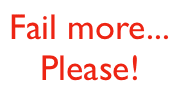 Perhaps you’re going to think I’ve been out in the sun too long when you read this proclamation: I want you to make more mistakes! What? It’s true, I do. But before you stop reading this article out of distain for such an absurd statement, please gift me just five minutes of your time to understand, from the perspective of neuroscience, why I want you to fail more.
Perhaps you’re going to think I’ve been out in the sun too long when you read this proclamation: I want you to make more mistakes! What? It’s true, I do. But before you stop reading this article out of distain for such an absurd statement, please gift me just five minutes of your time to understand, from the perspective of neuroscience, why I want you to fail more.
I’ve learned more from my mistakes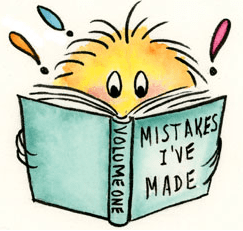
You’ve heard it. Maybe you’ve even said it: “I’ve learned more from the mistakes I’ve made in life than the things I’ve done right.” Is that coincidence? Or can it be validated with science? The answer is: It can be validated with science. To understand how this happens, let’s dive into the learning brain.
The learning brain
You have many kinds of memory and you learn things in many ways. The process of learning is, in fact, so complex, that I don’t want to take it on in this article. Stated simply, when you learn your brain makes connections between nerves – pathways from one piece of information to another. Think of it as driving your car to the grocery store. The pathway to the store is memorized in the brain so you can get there, almost automatically because you have traveled the pathway so frequently.
Road closed
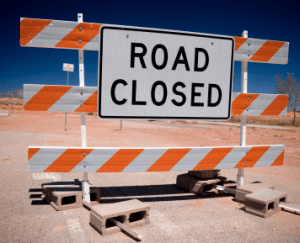 But what happens when the road you always travel on the way to the store is closed. If you have traveled alternate routes before, you know ways to get around the closure and you will likely be able to quickly and flawlessly navigate a new route. But what if you were in a strange town and you had to find your way around streets you never traveled before. It would take you a lot longer and you may end up getting lost. In fact, you might actually never make it to your destination before the store closes.
But what happens when the road you always travel on the way to the store is closed. If you have traveled alternate routes before, you know ways to get around the closure and you will likely be able to quickly and flawlessly navigate a new route. But what if you were in a strange town and you had to find your way around streets you never traveled before. It would take you a lot longer and you may end up getting lost. In fact, you might actually never make it to your destination before the store closes.
Finding new routes
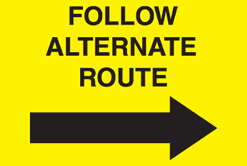 When your normal road of travel is closed, you wander around until you find a new road. Now, for all future trips to the store you have two, maybe even three ways to get there. If the first road is closed, or even congested, you can quickly and flawlessly take an alternate route.
When your normal road of travel is closed, you wander around until you find a new road. Now, for all future trips to the store you have two, maybe even three ways to get there. If the first road is closed, or even congested, you can quickly and flawlessly take an alternate route.
Roadways in the brain
 Think of practicing some skills over and over again as the equivalent of traveling the same road over and over again to the grocery store. So long as the road is open and passable, no worries. So long as the cognitive or muscle memory skill you are performing works, no worries. But what about when it doesn’t work. What are you to do then? Wander aimlessly, trying new ways to doing your task on the fly? The better solution might be to have alternate ways to accomplishing the task (i.e., alternate roadways) already memorized. Just in case.
Think of practicing some skills over and over again as the equivalent of traveling the same road over and over again to the grocery store. So long as the road is open and passable, no worries. So long as the cognitive or muscle memory skill you are performing works, no worries. But what about when it doesn’t work. What are you to do then? Wander aimlessly, trying new ways to doing your task on the fly? The better solution might be to have alternate ways to accomplishing the task (i.e., alternate roadways) already memorized. Just in case.
Building the roads
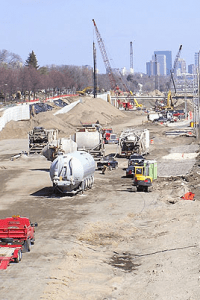 The alternate roadways in the brain provide you with solutions to problems when the regular solution doesn’t work. When you have alternates, you can become a resilient problem solver and find quick solutions to novel problems. The brain actually rewires itself (i.e., builds new roadways) as it learns from mistakes.
The alternate roadways in the brain provide you with solutions to problems when the regular solution doesn’t work. When you have alternates, you can become a resilient problem solver and find quick solutions to novel problems. The brain actually rewires itself (i.e., builds new roadways) as it learns from mistakes.
Building failure into training
You can help members become resilient problem solvers by building failure into training. However, I want to issue you a big fat warning. Building failure into training should only occur after the students have learned, practiced, memorized and perfected the RIGHT way to do things. Building their skills and confidence is very important.
Once they get good at the skills, then it’s time to build failure in. But don’t do it with malice. The road department always posts a sign to tell you the road is going to be closed. There’s a warning. Warn your students the same way. Tell them, in advance, that the evolution is going to fail and you want them to think of and implement novel solutions to the problem. Some novel solutions may work. Some may not. Out of failure, the brain rewires and builds new roadways and your students become resilient problems solvers – quickly able to detour around roadblocks that arise at emergency scenes.
The alternative is to drive the car through the barricades and into the ditch that’s been dug across the road. This is the equivalent of following SOPs or SOGs or scripted, rehearsed training all the way to failure at emergency scenes. It happens because students don’t know any better. They’re performing exactly to the script in a situation that is novel.
Dr. Gasaway’s Advice
 Train students for success based on best practices. Once they get really good at what they do and their confidence is high, tell them they need to learn novel solutions to unexpected situations and change the scenarios so that what they do will not work. Debrief the failures and discuss what worked and what did not and why. Challenge with questions like: What worked well? What didn’t work well? Why did things not work as you thought? What did you learn from this?
Train students for success based on best practices. Once they get really good at what they do and their confidence is high, tell them they need to learn novel solutions to unexpected situations and change the scenarios so that what they do will not work. Debrief the failures and discuss what worked and what did not and why. Challenge with questions like: What worked well? What didn’t work well? Why did things not work as you thought? What did you learn from this?
This purpose of scripted failures is not to embarrass. It’s to build alternate solutions into the collection of mental options. Make sure everyone knows this up front. Enthusiastic students will then welcome the opportunity to fail for the sake of learning and will not resent the instructor who seems to be taking joy in the sadistic act of creating failure among students.
NOTE: Always ensure safety best practices when building failure into evolutions. It is never the goal to teach someone a lesson by allowing them to get hurt or be put into harm’s way unnecessarily. That is negligent behavior on behalf of the instructor or supervisor.
 Discussions
Discussions
1. Discuss some examples where you’ve learned from a mistake. What went wrong? What did you learn from it? Why was the lesson so powerful for you?
2. Discuss how you build failure into training evolutions by introducing unexpected events or undesired outcomes.
3. Discuss an emergency incident where something did not go as planned and valuable lessons resulted from the experience.
_____________________________________________________

If you are interested in taking your understanding of situational awareness and high-risk decision making to a higher level, check out the Situational Awareness Matters Online Academy.
CLICK HERE for details, enrollment options and pricing.
__________________________________
Share your comments on this article in the “Leave a Reply” box below. If you want to send me incident pictures, videos or have an idea you’d like me to research and write about, contact me. I really enjoy getting feedback and supportive messages from fellow first responders. It gives me the energy to work harder for you.
Thanks,

Email: Support@RichGasaway.com
Phone: 612-548-4424
SAMatters Online Academy
Facebook Fan Page: www.facebook.com/SAMatters
Twitter: @SAMatters
LinkedIn: Rich Gasaway
Instagram: sa_matters
YouTube: SAMattersTV
iTunes: SAMatters Radio
iHeart Radio: SAMatters Radio

Rich:
I recently attended a leadership seminar where all of the speakers talked about building trust by having “uncomfortable conversations.” Trust is the cornerstone for learning and building cohesive teams. And failure is a part of reality, so we have to “season” our training with unexpected events and stressful situations that place extreme demands on our decision making and skill-abilities. We need to build “uncomfortable situations” into all of our learning (bringing thinking to action), but HOW we do that is the difference between creating a learning and growing experience or a failing outcome that demotivates or produces unsafe and ineffective procedures.
I couldn’t agree with you more, “learn, practice, memorize and perfect the RIGHT way to do things.” In other words, build the skill and the will first, then challenge them to create the desired team performance. Kind of like Lombardi’s quote, “Practice does not make perfect. Only perfect practice makes perfect.”
Our challenge, in a large department that covers lots of geography, is building and maintaining those basic skills so we can continue to grow and get better. For us, it’s all about having a plan and EXECUTING that plan. We’re working on it.
As always, thanks for helping us start those “uncomfortable conversations.”
Billy
Billy,
Thanks for sharing your comments and your experience. Your perspective adds value to the topic and it is important for our readers to benefit from these discussions. I like your quote about practice. In my programs I often say “Practice does not make perfect. Practice makes permanent.” Combining your quote with me would yield: “Perfect practice makes perfect permanent performance.” Wow, that’s a lot of “P’s.” Stay safe my friend!
Rich
Rich,
Good post about helping students deal with situations in which their best plans (and second, and third, etc.) are met with failure. Unfortunately, the Fire Service has too many incidents in which officers neglected the signs that their strategies or tactics were failing, yet forged on ahead to tragic results.
One point I would add based on a recent study I participated in regarding officer training–how to handle officers who are not performing well in front of their crew. In our situation, we didn’t build in failure explicitly, but some were hard scenarios. Since the exercises involved the whole crew, or multiple companies (in the case of executive officers), we were very sensitive to when the candidates were going down a bad path in front of their crew.
While the purpose of the exercises was to reveal performance issues, we also realized that there is a right and wrong way to handle such revelations. We certainly didn’t want to sugarcoat bad performance decisions, but we felt that the crew has to have confidence in their leader, and so fitting into your “not to embarrass” anyone, we made sure that if things were going south, we either finished the scenario or moved into a ‘guided instruction’ mode.
Maybe you have some thoughts on handling those sticky situations where you don’t want to embarrass the candidate, but you also need to correct some problems while other members of the department are present?
Jonathan,
Thanks for posting your comment and contributing to the SAMatters community. I appreciate that very much. In response to your question, I would try to make a habit of doing small after action reviews of training incidents and have each student, after each evolution, identify something that went well and something they think they could have improved on. This way, no one is singled out for good performance or bad. Let the student conduct the self evaluation and as the group gets comfortable, they can engage in a dialog about what went well and what can be improved.
The important thing is to get the lessons out there in a way that is not embarrassing or harmful to the firefighter who made the mistake. I know some would say we’re treating them like babies and they should “man-up” or “woman-up” and take the criticism. That is so old-school leadership. It doesn’t work well. The drill master hard-ass thinks it does. But it only leads to resentment. That’s no way to lead.
Rich
Thank you, Samatters, for putting together everything about Crowd Control. I think you have covered all the major points in this article, I will share this with my network as well.